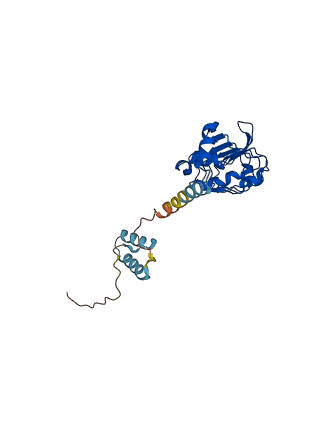P43333
Gene name |
At1g09760 (F21M12.14) |
Protein name |
U2 small nuclear ribonucleoprotein A' |
Names |
U2 snRNP A' |
Species |
Arabidopsis thaliana (Mouse-ear cress) |
KEGG Pathway |
ath:AT1G09760 |
EC number |
|
Protein Class |
|

Descriptions
The autoinhibited protein was predicted that may have potential autoinhibitory elements via cis-regPred.
Autoinhibitory domains (AIDs)
Target domain |
|
Relief mechanism |
|
Assay |
cis-regPred |
Accessory elements
No accessory elements
Autoinhibited structure

Activated structure

1 structures for P43333
| Entry ID | Method | Resolution | Chain | Position | Source |
|---|---|---|---|---|---|
| AF-P43333-F1 | Predicted | AlphaFoldDB |
7 variants for P43333
| Variant ID(s) | Position | Change | Description | Diseaes Association | Provenance |
|---|---|---|---|---|---|
| tmp_1_3161571_T_A | 11 | K>N | No | 1000Genomes | |
| ENSVATH10856869 | 12 | S>I | No | 1000Genomes | |
| tmp_1_3161406_A_G | 33 | V>A | No | 1000Genomes | |
| ENSVATH01028614 | 110 | A>S | No | 1000Genomes | |
| ENSVATH01028613 | 129 | A>P | No | 1000Genomes | |
| ENSVATH00014059 | 148 | I>V | No | 1000Genomes | |
| ENSVATH04546107 | 173 | K>E | No | 1000Genomes |
No associated diseases with P43333
1 regional properties for P43333
| Type | Name | Position | InterPro Accession |
|---|---|---|---|
| domain | U2A'/phosphoprotein 32 family A, C-terminal | 128 - 146 | IPR003603 |
6 GO annotations of cellular component
| Name | Definition |
|---|---|
| Cajal body | A class of nuclear body, first seen after silver staining by Ramon y Cajal in 1903, enriched in small nuclear ribonucleoproteins, and certain general RNA polymerase II transcription factors; ultrastructurally, they appear as a tangle of coiled, electron-dense threads roughly 0.5 micrometers in diameter; involved in aspects of snRNP biogenesis; the protein coilin serves as a marker for Cajal bodies. Some argue that Cajal bodies are the sites for preassembly of transcriptosomes, unitary particles involved in transcription and processing of RNA. |
| cytoplasm | The contents of a cell excluding the plasma membrane and nucleus, but including other subcellular structures. |
| nucleolus | A small, dense body one or more of which are present in the nucleus of eukaryotic cells. It is rich in RNA and protein, is not bounded by a limiting membrane, and is not seen during mitosis. Its prime function is the transcription of the nucleolar DNA into 45S ribosomal-precursor RNA, the processing of this RNA into 5.8S, 18S, and 28S components of ribosomal RNA, and the association of these components with 5S RNA and proteins synthesized outside the nucleolus. This association results in the formation of ribonucleoprotein precursors; these pass into the cytoplasm and mature into the 40S and 60S subunits of the ribosome. |
| nucleoplasm | That part of the nuclear content other than the chromosomes or the nucleolus. |
| nucleus | A membrane-bounded organelle of eukaryotic cells in which chromosomes are housed and replicated. In most cells, the nucleus contains all of the cell's chromosomes except the organellar chromosomes, and is the site of RNA synthesis and processing. In some species, or in specialized cell types, RNA metabolism or DNA replication may be absent. |
| ribonucleoprotein complex | A macromolecular complex that contains both RNA and protein molecules. |
1 GO annotations of molecular function
| Name | Definition |
|---|---|
| U2 snRNA binding | Binding to a U2 small nuclear RNA (U2 snRNA). |
1 GO annotations of biological process
| Name | Definition |
|---|---|
| mRNA splicing, via spliceosome | The joining together of exons from one or more primary transcripts of messenger RNA (mRNA) and the excision of intron sequences, via a spliceosomal mechanism, so that mRNA consisting only of the joined exons is produced. |
| 10 | 20 | 30 | 40 | 50 | 60 |
| MVKLTADLIW | KSPHFFNAIK | ERELDLRGNK | IPVIENLGAT | EDQFDTIDLS | DNEIVKLENF |
| 70 | 80 | 90 | 100 | 110 | 120 |
| PYLNRLGTLL | INNNRITRIN | PNLGEFLPKL | HSLVLTNNRL | VNLVEIDPLA | SIPKLQYLSL |
| 130 | 140 | 150 | 160 | 170 | 180 |
| LDNNITKKAN | YRLYVIHKLK | SLRVLDFIKI | KAKERAEAAS | LFSSKEAEEE | VKKVSREEVK |
| 190 | 200 | 210 | 220 | 230 | 240 |
| KVSETAENPE | TPKVVAPTAE | QILAIKAAII | NSQTIEEIAR | LEQALKFGQV | PAGLIIPDPA |
| TNDSAPMEE |